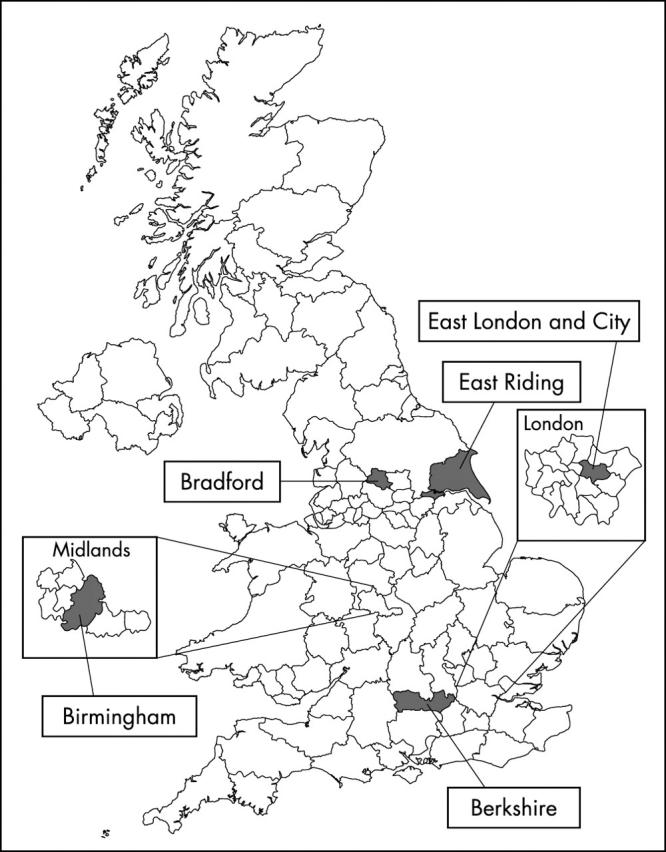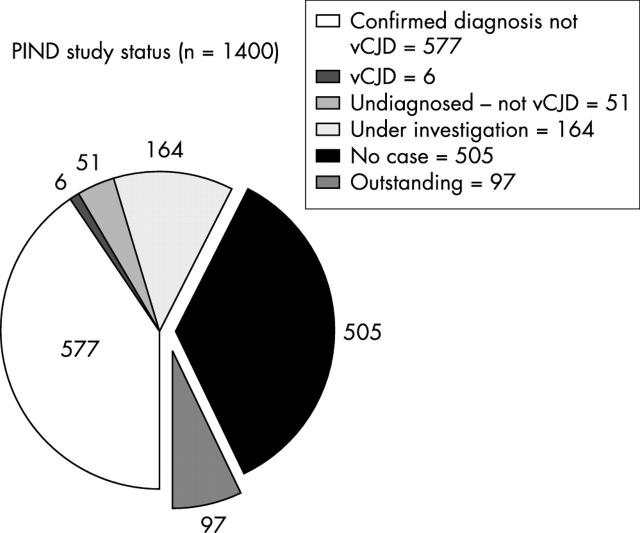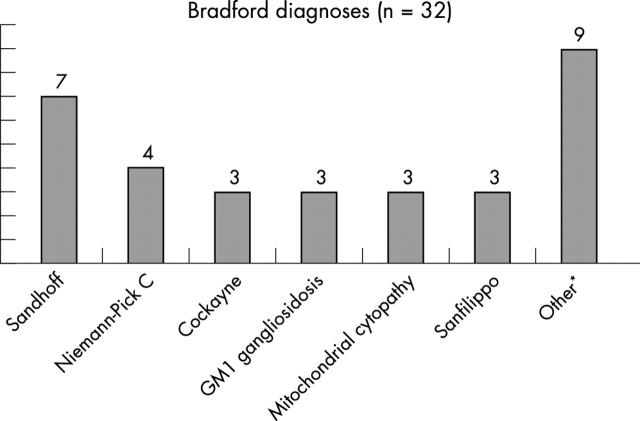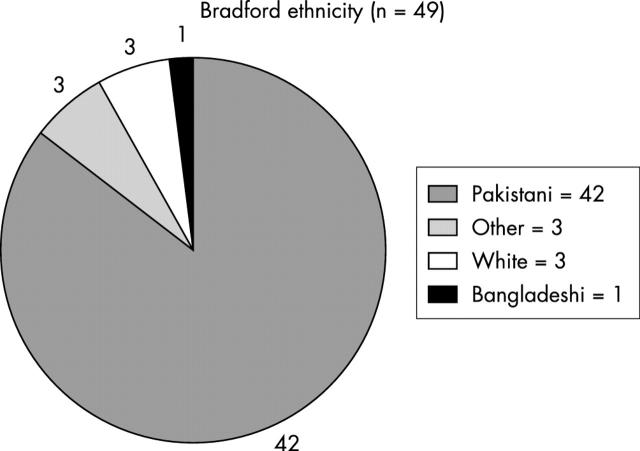Abstract
Aims: To identify any UK children with variant Creutzfeldt-Jakob disease (vCJD) and obtain information about the causes of progressive intellectual and neurological deterioration (PIND) and the geographical distribution of cases.
Methods: The PIND Study uses the monthly surveillance card that is sent to all UK paediatricians by the British Paediatric Surveillance Unit. Case details are obtained from the reporting paediatricians by telephone interview, site visit, or self completion of a questionnaire. A paediatric neurology expert group then classifies the anonymised cases. The Communicable Disease Surveillance Centre (CDSC) provides mapping support.
Results: After five years and five months of surveillance, 1400 children had been reported. In the UK the majority of PIND cases had a confirmed diagnosis (comprising 99 different conditions); 505 "no cases" and 97 "outstanding" cases were excluded. A total of 798 PIND cases were included as follows: 577 with a confirmed underlying diagnosis; six with definite or probable vCJD, 51 who had undiagnosed PIND but were not thought to have vCJD, and 164 cases who were still under investigation. In some districts there were unexpectedly high numbers of PIND cases with a heterogeneous mixture of underlying diagnoses. In the five districts with the largest numbers of resident cases the majority not only came from a particular ethnic group but also had high reported rates of consanguinity.
Conclusions: In districts with large numbers of PIND cases there are major resource implications. These children and their families have complex problems and they need access to diagnostic facilities and appropriate service provision.
Full Text
The Full Text of this article is available as a PDF (391.5 KB).
Figure 1 .
Total PIND cases by study category. "No cases" (n = 505) and "outstanding" cases (n = 97) were excluded from the analysis and are shown exploded. The remaining 798 cases were analysed according to the PHLS health district of residence as described in the text.
Figure 2 .

Map of the UK showing PHLS districts. The five highlighted districts are those in which the largest numbers of PIND cases resided.
Figure 3 .
The five most frequently diagnosed causes of PIND in the UK.
Figure 4 .
The causes of PIND diagnosed in Bradford.
Figure 5 .
All UK PIND cases; ethnicity.
Figure 6 .
Bradford PIND cases; ethnicity.
Selected References
These references are in PubMed. This may not be the complete list of references from this article.
- Avard Denise M., Knoppers Bartha M. Ethical dimensions of genetics in pediatric neurology: a look into the future. Semin Pediatr Neurol. 2002 Mar;9(1):53–61. doi: 10.1053/spen.2002.30342. [DOI] [PubMed] [Google Scholar]
- Bundey S., Alam H. A five-year prospective study of the health of children in different ethnic groups, with particular reference to the effect of inbreeding. Eur J Hum Genet. 1993;1(3):206–219. doi: 10.1159/000472414. [DOI] [PubMed] [Google Scholar]
- Davidson Emily J., Silva Thomas J., Sofis Lisa A., Ganz Michael L., Palfrey Judith S. The doctor's dilemma: challenges for the primary care physician caring for the child with special health care needs. Ambul Pediatr. 2002 May-Jun;2(3):218–223. doi: 10.1367/1539-4409(2002)002<0218:tdsdcf>2.0.co;2. [DOI] [PubMed] [Google Scholar]
- Davies H. Living with dying: families coping with a child who has a neurodegenerative genetic disorder. Axone. 1996 Dec;18(2):38–44. [PubMed] [Google Scholar]
- Declich S., Carter A. O. Public health surveillance: historical origins, methods and evaluation. Bull World Health Organ. 1994;72(2):285–304. [PMC free article] [PubMed] [Google Scholar]
- Gravelle A. M. Caring for a child with a progressive illness during the complex chronic phase: parents' experience of facing adversity. J Adv Nurs. 1997 Apr;25(4):738–745. doi: 10.1046/j.1365-2648.1997.1997025738.x. [DOI] [PubMed] [Google Scholar]
- Hunt A., Burne R. Medical and nursing problems of children with neurodegenerative disease. Palliat Med. 1995 Jan;9(1):19–26. doi: 10.1177/026921639500900104. [DOI] [PubMed] [Google Scholar]
- Hutchesson A. C., Bundey S., Preece M. A., Hall S. K., Green A. A comparison of disease and gene frequencies of inborn errors of metabolism among different ethnic groups in the West Midlands, UK. J Med Genet. 1998 May;35(5):366–370. doi: 10.1136/jmg.35.5.366. [DOI] [PMC free article] [PubMed] [Google Scholar]
- Morton R., Sharma V., Nicholson J., Broderick M., Poyser J. Disability in children from different ethnic populations. Child Care Health Dev. 2002 Jan;28(1):87–93. doi: 10.1046/j.1365-2214.2002.00245.x. [DOI] [PubMed] [Google Scholar]
- Reefhuis Jennita, Honein Margaret A., Whitney Cynthia G., Chamany Shadi, Mann Eric A., Biernath Krista R., Broder Karen, Manning Susan, Avashia Swati, Victor Marcia. Risk of bacterial meningitis in children with cochlear implants. N Engl J Med. 2003 Jul 31;349(5):435–445. doi: 10.1056/NEJMoa031101. [DOI] [PubMed] [Google Scholar]
- Roberts G. Supporting children with serious health care needs. Analyzing the costs and benefits. Eval Health Prof. 2001 Mar;24(1):72–83. doi: 10.1177/01632780122034803. [DOI] [PubMed] [Google Scholar]
- Sinha G., Corry P., Subesinghe D., Wild J., Levene M. I. Prevalence and type of cerebral palsy in a British ethnic community: the role of consanguinity. Dev Med Child Neurol. 1997 Apr;39(4):259–262. doi: 10.1111/j.1469-8749.1997.tb07422.x. [DOI] [PubMed] [Google Scholar]
- Verity C. M., Nicoll A., Will R. G., Devereux G., Stellitano L. Variant Creutzfeldt-Jakob disease in UK children: a national surveillance study. Lancet. 2000 Oct 7;356(9237):1224–1227. doi: 10.1016/s0140-6736(00)02785-9. [DOI] [PubMed] [Google Scholar]
- Verity C., Preece M. Surveillance for rare disorders by the BPSU. The British Paediatric Surveillance Unit. Arch Dis Child. 2002 Oct;87(4):269–271. doi: 10.1136/adc.87.4.269. [DOI] [PMC free article] [PubMed] [Google Scholar]







